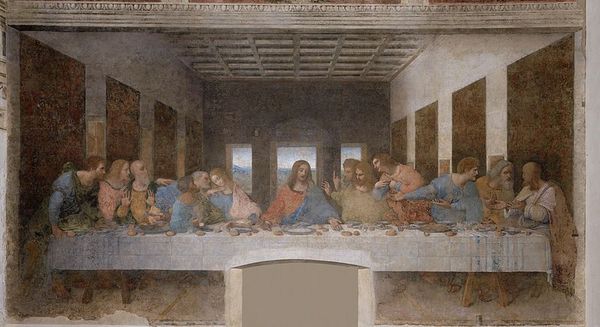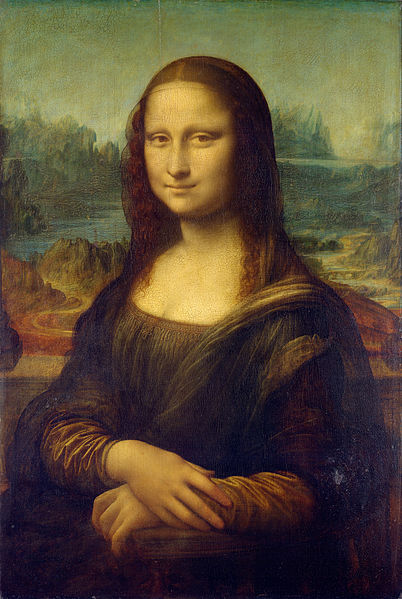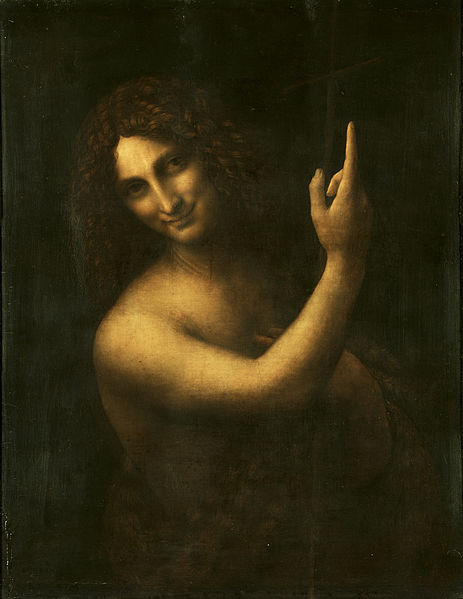Leonardo da Vinci
"And now Children" Grandmother began, "we have arrived at "The Golden Age of Painting", for it was during this period that the three greatest painters the world has ever known lived. They are Leonardo da Vinci, Michel Angelo, and Raphael.
Leonardo, the first of this group, was born in Vinci, Italy in 1452, and we are told that his talent and genius were so universal that he was skilled in all the arts and sciences. The masterpieces he has handed down to us in the art world, have won for him the undisputed title of the "Father of the Great Painters of the Renaissance." But painting was not his only accomplishment for he was a sculptor of note, an architect and engineer, a writer, a musician, and playwright, besides excelling in many of the other arts and sciences.
The art world is indebted to him for the three great paintings he left behind him. They are "The Last Supper", "The Mona Lisa" and "The Struggle for the Standard".

The Last Supper, 1495
See The Last Supper Restored
Leonardo Da Vinci (1452-1519)
The Last Supper, as I told you in the beginning of the story, is one of the world's greatest masterpieces, and is by far the most popular and best known of Leonardo's Paintings, for copies of this beautiful picture may be found in the dining rooms of rich and poor alike, bestowing a silent benediction on the heads of the diners.
"The Struggle for the Standard" is a fresco that beautifies the walls of Palazzo Vecchio, Florence, and although never completed, it is considered one of the greatest paintings of the ages.
We are told this work was produced by Leonardo in a competition with Michel Angelo, another giant of the "Golden Age", whose competitive painting is entitled "Bathing Soldiers." Neither fresco was ever finished as Michael Angelo was called to Rome before he could complete his work, and Leonardo, dissatisfied with the development of his subject, quit at the same time.
Leonardo received his early education in Florence, and later in the studio of Andrea Verrocchio, a painter, goldsmith, and sculptor, he was imbued with the essentials that later developed into perfection in the art of painting and distinguished Leonardo as one of the greatest artist the world has ever known.
His earliest paintings were produced under the direction and supervision of Verrocchio, but not any of the pictures done by him at that time have come down to us.
It was not until after he had completed his training, and could record his own ideas and impressions without restrictions that his really great pictures were painted.
In 1483 he entered the service of the Duke of Milan where his court life proved a busy one. For twenty years that city was enriched by his services for the Duke kept him busy with painting, sculpture, architecture, writing, engineering, and music. His duties were of a political as well as a social nature.
But in the midst of all this activity, Leonardo found time to plan and produce art's most priceless treasure, his masterpiece, and the world's greatest painting, "The Last Supper."
In 1503, Leonardo returned to the home of his youth, the city of Florence, and about that time began work on his unfinished fresco, "The Struggle for the Standard."
Four years later he produced his other great painting, "The Mona Lisa."

The Mona Lisa, 1503
Leonardo Da Vinci (1452-1519)
Then followed a period of inactivity until 1515, when at the age of sixty three, he receive a generous offer from Francis I, King of France. With a heart full of gratitude to the French King, the aging artist left his native land and was soon installed in a chateau near the King's palace where he began to paint a picture of St. John, the Baptist, the first commission in the French Court.
Now when he left Italy, he brought with him to his new home all the movable possessions he values, and among them was his picture of the Mona Lisa for which he had so great an affection that he could not bear to be separated from it. And in his new home, he hung the picture in his studio where he could see it while he worked.
We are told that one day while Leonardo was busily engaged with his picture of St. John the Baptist, the King called on him to see for himself how the work was progressing. Upon entering the studio, the first thing that attracted his attention was the Mona Lisa and he immediately forgot everything else. In fact, he was so enthralled by the painting that he was determined to possess it himself, and made Leonardo a generous offer. But the aged man only looked at him in trepidation. He could not answer him, for the thought of parting with his beloved work was too much for him. The king, finally losing patience, left the studio and returned to his castle, but later in the day, upon being convinced that the picture had no commercial value for the artist, he relented, and Leonardo was happy again.

St. John the Baptist, 1514
Leonardo Da Vinci (1452-1519)
An amicable agreement was reached between the artist and King Francis. Both men realized that Leonardo did not have many years to live and the possession of the picture would make his last lonely days happier. And so the French King generously paid him for the picture with the understanding that when Leonardo passed out of this life, it would become the King's property.
For four more years the aged artist lived, and when he died in 1519, Francis I, King of France became the owner of the Mona Lisa.
Later, the picture was hung in the Louvre, and in 1911, this priceless treasure was cut from its frame and stolen.
For two years, an untiring search went on for the missing Masterpiece. Every art lover in the world lamented its loss, and there was universal rejoicing when it was finally found in the possession of one of Leonardo's countrymen, whose patriotic feeling prompted the theft.
"As that is about all I can tell you about Leonardo, children," Grandmother continues, "we will take up the story of Michel Angelo, another giant of the Golden Age of Art.
| Page 12 | Beginning of Book | Page 14 |